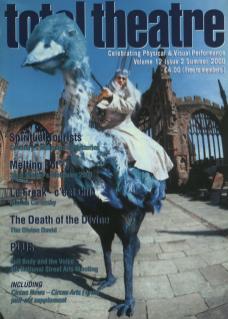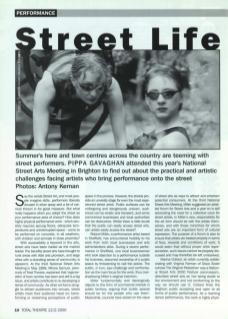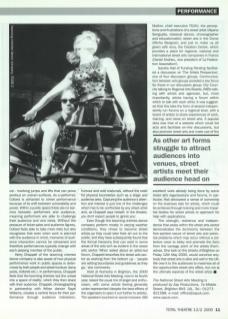Say the words Street Art, and most people imagine stilts, performers liberally doused in silver spray, and a bit of carnival thrown in for good measure. But what really happens when you adopt the street as your performance area of choice? How does highly physical performance work – which sensibly requires sprung floors, adequate temperatures and uninterrupted space – come to be performed on concrete, in all weathers, with children and animals in close proximity?
With accessibility a keyword in the arts, street arts have been hailed as the market leader. The benefits street arts have brought to rural areas with little arts provision, and large cities with a dwindling sense of community, is apparent. At the third National Street Arts Meeting in May 1999, Mhora Samuel, previously of Total Theatre, explained that regeneration of town centres has been and still is a big issue, and artists contribute to redeveloping a sense of community. As other artforms struggle to attract audiences into venues, street artists meet their audience head on; transforming or reclaiming perceptions of public space in the process. However, the streets provide an unwieldy stage for even the most experienced street artist. Public surfaces can be unforgiving and dangerously uneven, audiences can be erratic and transient, and some commercial businesses and local authorities can be obstructive. Whilst there is little doubt that the public can easily access street arts, can artists easily access the street?
As other art forms struggle to attract audiences into venues, street artists meet their audience head on
Roland Miller, a performance artist based in Sheffield, has encountered hostility to his work from both local businesses and arts administrators alike. During a recent performance in Sheffield, one local businessman who took objection to a performance outside his business, assumed ownership of a public space by threatening to call the police. The public, in turn, saw challenge and confrontation as the main focus for the work, thus overshadowing Miller's original intention.
Miller fundamentally and ideologically objects to this form of commercial interest in public territory, arguing that public spaces should be ‘for the people who use them'. Meanwhile, councils have seized on the value of street arts as ways to attract and entertain potential consumers. At the third National Street Arts Meeting, Miller suggested an artist-led forum for Street Arts and a year on is still advocating the need for a collective voice for street artists. In Miller's view, responsibility for the artform should be with the artists themselves, and with those minorities for whom street arts are an important form of cultural expression. The purpose of a forum is also to ensure that artists are treated property in terms of fees, rewards and conditions of work. It would seem that without proper artist representation, such issues cannot be properly discussed and may therefore be left unresolved.
Marina Collard, an artist currently collaborating with Virginia Farman of Disco Sister (whose The Original Pedestrian was a National Street Arts 2000 Festival commission), describes street arts as 'not being docile to the environment and not conforming to the way we should use it’. Collard finds the Brighton public accepting and open to all forms of public performance. As a roaming dance performance, the work is highly physical – involving jumps and lifts that can prove perilous on uneven surfaces. As a performer, Collard is attracted to street performance because of its shift between vulnerability and power. Within a public space there are no barriers between performers and audience, meaning performers are able to challenge their audience and vice versa. Without the pressure of ticket sales and audience figures, Collard feels able to take more risks but also recognises that even when work is planned with the audience in mind, moments of audience interaction cannot be rehearsed and therefore performances typically change with each passing member of the public.
Kerry Chappell of the booming cherries dance company is also aware of how physical performance work in public spaces is determined by both people and street furniture (lamp posts, bollards, etc). In performance, Chappell feels that the booming cherries put the unreal into a space of reality, which they then share with their audience. Chappell, choreographing in partnership with fellow dancer Saydi Williams, creates a central focus for their performance through audience interaction, humour and vivid costumes, without the need for physical boundaries such as a stage and audience area. Capturing the audience's attention and interest is just one of the challenges which has to be confronted by any street artist and, as Chappell says herself, 'in the theatre, you don't expect people to ignore you’.
Even though the booming cherries dance company perform mostly in varying weather conditions, they chose to become street artists so they could take their art out to the public, and they have subsequently found that the formal hierarchy that can exist in some areas of the arts isn't as evident in the street arts sector. When asked about an artist-led forum, Chappell describes the street arts sector as working from the bottom up – ‘people are setting boundaries and guidelines as they go,’ she comments.
Held at Komedia in Brighton, the 2000 National Street Arts Meeting, now in its fourth year, raised the usual mix of anger and enthusiasm, with some artists feeling generally under-represented (despite the best efforts of the organisers to open it out further to artists). The speakers touched on social inclusion (Bill Mather, chief executive TS2K); the perceptions and frustrations of a street artist (Alpana Sengupta, classical dancer, choreographer and educationalist); street arts in the Dome (Micha Bergese); and just to make us all green with envy, the Creation Centre, which provides a place for regional, national and international street arts companies in France (Daniel Andrieu, vice president of 'La Federation Association').
Sandra Hall of Funding Pending facilitated a discussion on ‘The Artist’s Perspective', one of four discussion groups. Communication between arts groups provided a key focus for those in our discussion group; City Councils talking to Regional Arts Boards, RAB's talking with artists and agencies, but most importantly, artists having a forum within which to talk with each other. It was suggested that this take the form of several independently run forums on a regional level, with a board of artists to share experiences of work, training, and views on street arts. A popular idea was that of a website which could list acts and facilitate online discussions, but also promote street arts and make use of the excellent work already being done by some street arts organisations and forums. In particular, Hall advocated a sense of ownership on the business side for artists, which could be achieved through training and more impartial bodies for street artists to approach for help with applications.
The strength, resilience and independence that exists within the street arts sector demonstrates the dichotomy between the free-spirited nature of street arts and potential problems which may occur without a collective voice to lobby and promote the form from the vantage point of the artists themselves. One look on the streets of Brighton on Friday 12 May 2000, would convince anybody that street arts is alive and well in the UK. We owe it to the audiences to maximise all of the opportunities street arts offers, but not at the ultimate expense of the street artist.
The National Street Arts Meeting is produced by Zap Productions, 7a Middle Street, Brighton BN1 1AL. www.zapuk.com


